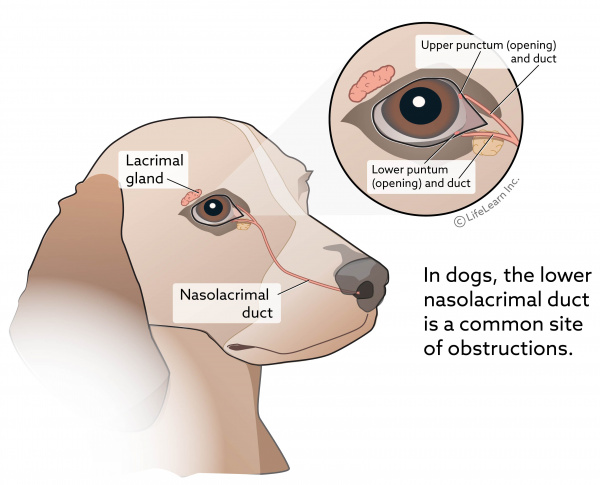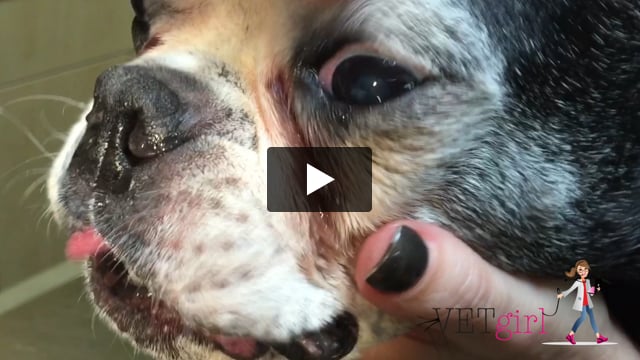
In dogs and cats it is possible but rare that the obstruction can be caused by an underlying tooth root infection or tumor. The described method is relatively straightforward thereby making relief of tear outflow problems widely accessible.

In these causes anti-inflammatory medications and antibiotics may alleviate the obstruction.
Nasolacrimal duct obstruction dog. Many cases of nasolacrimal duct obstruction are caused by inflammation. In these causes anti-inflammatory medications and antibiotics may alleviate the obstruction. Use all medications as recommended by your veterinarian and return for all scheduled rechecks in order to maximize the chances of resolving your dogs lacrimal duct obstruction.
Nasolacrimal duct and creating a negative pressure as the sac reopens which draws tears into the canaliculus and lacrimal sac. Pseudo-peristalsis within the nasolacrimal duct also moves tears to the nasal punctum. If the nasolacrimal system is obstructed clinical signs include an ocular discharge varying from.
Primary tumors of the lacrimal sac or duct are very rare. A cystic structure that develops from an embryonic malformation of the canaliculus or nasolacrimal duct. Mesocephalic and dolichocephalic dogs.
Previous upper respiratory tract infections. In the dog the obstruction is often caused by a foreign body. In dogs and cats it is possible but rare that the obstruction can be caused by an underlying tooth root infection or tumor.
In contrast in rabbits tooth root problems are a common problem. Dacryocystitis inflammation of the lacrimal sac usually is caused by obstruction of the nasolacrimal sac and proximal nasolacrimal duct by inflammatory debris foreign bodies or masses pressing on the duct. The naso-lacrimal duct tear duct is a passageway connecting the eye to the nose and mouth.
Tears produced in the eye normally drain through this duct. There are two openings puncta to the duct on each eye. One is located on the upper lid and the other is on the lower lid.
Despite its rarity a canaliculocele should be considered in adult dogs with nasolacrimal duct obstruction. Marsupialisation seems to be the appropriate therapy. The lacrimal or tear gland located at the top outer edge of the eye produces the watery portion of tears.
Nasolacrimal ducts allow tears to drain from each eye into the nose. Disorders of these structures can lead to either eyes that water excessively or dry eyes. They may be congenital present at birth or caused by infection foreign.
In dogs the nasolacrimal duct commonly has an opening into the nasal cavity between the lacrimal sac and the nasal opening although the remainder of the duct is intact. In rabbits the nasolacrimal duct has multiple sharp bends and constricted areas which may be associated with the frequency of duct obstruction and dacryocystitis in this species. If the nasolacrimal duct is suspected of being blocked your dog will be anesthetized and a special instrument will be inserted into the duct to flush out the contents.
In some cases the lacrimal puncta or opening may have failed to open during the dogs development and if this is the case it can be surgically opened during this procedure. Furthermore a nasolacrimal duct obstruction can also be treated simultaneously with the tip of a dacryoendoscope Yamada et al 2009. The purpose of this case report was to present an account of diagnosis and treatment tool of dacryocystitis in the eyes of dogs using dacryoendoscopy.
In brachycephalic breeds of dogs and cats the nasolacrimal duct is considerably shorter and tortuous and fluorescein may exit the nasolacrimal duct to enter the nasopharynx rather than the external nares. In any breed of dog if the dogs head is restrained upward during the test the dye can also collect in the nasopharynx. Nasolacrimal duct flushing is indicated to determine andor restore patency of the nasolacrimal ducts when rabbits present with an ocular discharge.
Common causes of nasolacrimal duct obstruction can include infectious agents and dental disease. Canaliculorhinostomy as a treatment for nasolacrimal duct obstruction in dogs and cats. The described method is relatively straightforward thereby making relief of tear outflow problems widely accessible.
Do dogs get blocked tear ducts. The tear ducts drain tears into the back of the nose and the throat. Epiphora is most commonly associated with insufficient drainage of the tear film from the eye.
The most common cause of insufficient tear. While not as common in cats as in dogs this nasolacrimal duct can become obstructed or blocked. Obstruction may result in tears overflowing and running out of the eye.
This overflow of tears can lead to moisture and tear staining below the eye. Nasolacrimal Duct Obstruction. On September 13 2016 Cats Common Animal Eye Conditions Dogs.
The naso-lacrimal duct tear duct is a passageway connecting the eye to the nose and mouth. Tears produced in the eye normally drain through this duct. Despite the theoretical possibility that tooth extraction could result in nasolacrimal duct obstruction to the best of our knowledge no cases have yet been reported.
In the present study we describe a case in which the nasolacrimal duct was partially obstructed after extraction of an impacted maxillary canine causing paranasal discomfort and lower eyelid swelling. Flushing the nasolacrimal duct and cannulating the lacrimal punctae in dog veterinary. A 15-year-old spayed female English setter dog was presented because of mucopurulent discharge emanating from the left medial canthal region of 8-months duration despite medical management and repeated nasolacrimal flushing.
Dacryocystorhinography demonstrated obstruction at the level of the lacrimal sac. To create a replacement nasolacrimal system using the puncta and canaliculi with prolonged implant retention and minimal use of Elizabethan collars or other restraint devices. The method was used in 11 dogs and two cats.
Silicone tubing was placed through both canaliculi and via a drill hole into the nasal cavity. Distally the tubing ends were tied in a. Avoid exposing your dog and their eyes to airborne dust and debris that can accumulate in naso-lacrimal ducts and cause inflammation infection and blockage.
Seek veterinary attention as soon as possible for eye conditions before chronic complications become an issue.